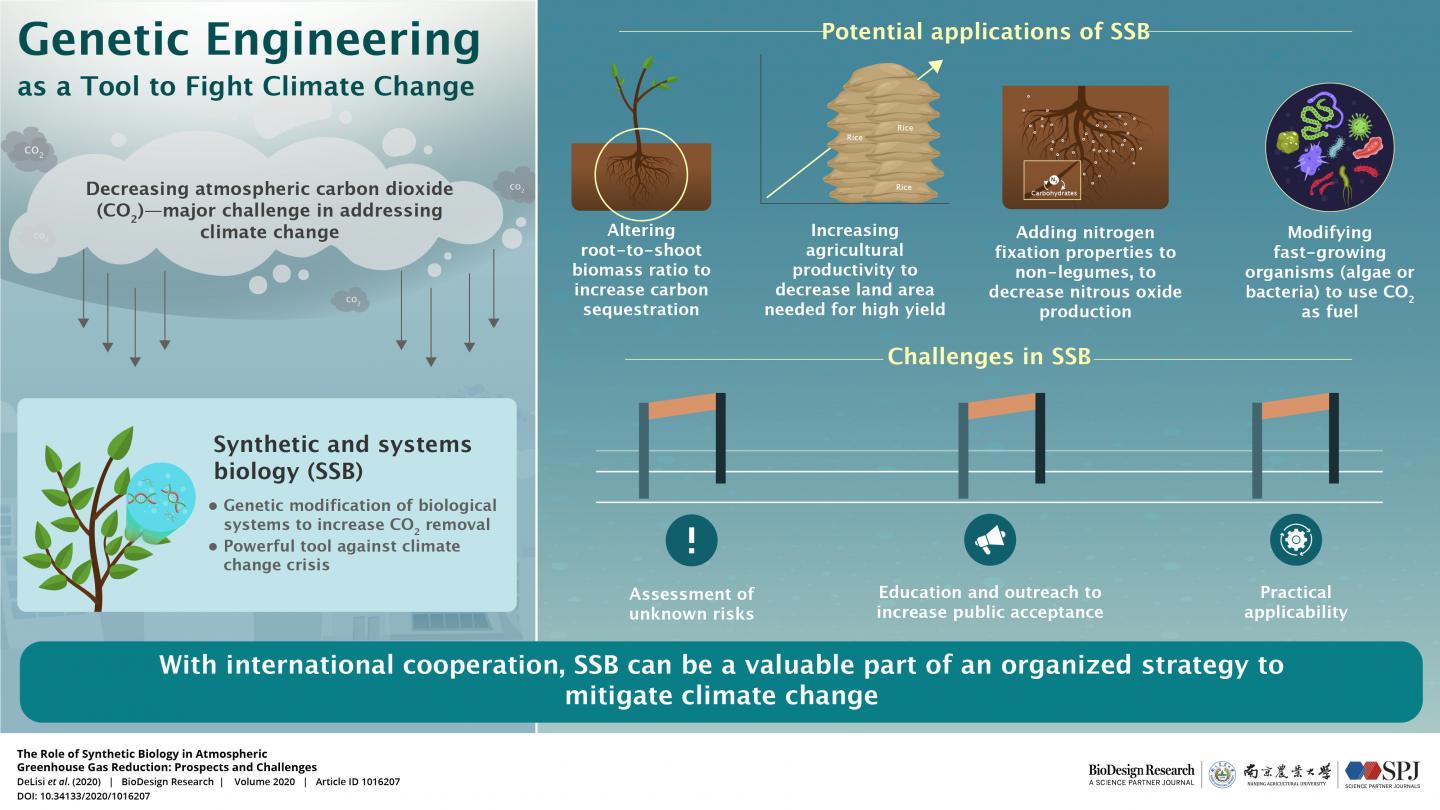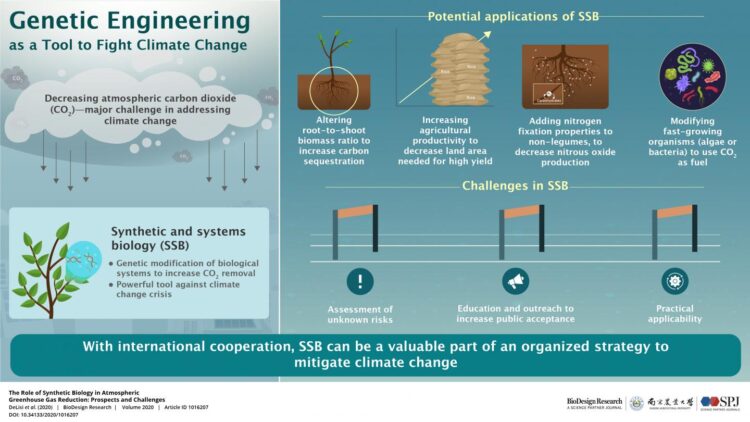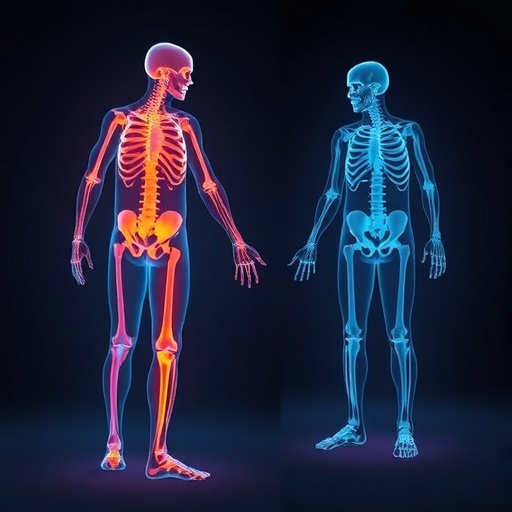Scientists explain how genetically engineered organisms can help us diminish atmospheric carbon and tackle climate change

Credit: @BioDesign Research
@Nanjing Agriculture University
@SPJ
Climate change is a major global crisis. Despite international agreements to fight climate change, greenhouse gas emissions continue to increase and global temperatures continue to rise. The potential effects on our lives are drastic: recent wildfires in the US and Australia, floods due to heavier precipitation, and heavy losses of crops are all indicative of this. But simply reducing the production of greenhouse gases, although crucial, is not enough. The CO2 that we’ve released, and are continuing to release into the atmosphere, remains there indefinitely. Climate change will thus continue to worsen unless atmospheric carbon is removed. Therefore, finding cutting-edge solutions for the active removal of greenhouse gases is crucial.
With this in mind, a group of scientists from the US and Israel have proposed a CO2 removal strategy that utilizes the powerful methods of synthetic and systems biology (SSB). The further development and deployment of SSB could enable the modification of plants to remove CO2 from the atmosphere irreversibly. At a symposium held in Boston, the scientists discussed their ideas for mitigating the negative effects of climate change, with their findings published in BioDesign Research. Professor Charles DeLisi of Boston University, lead author of this paper, explains this concept using an interesting analogy, “Engineers learned long ago how to design and manufacture circuits to perform desired tasks. In the past two decades, biomedical engineers have begun to learn to design and manipulate the circuitry that enables cells to carry out biological processes with enhanced functions: in this case, CO2 removal . “
In this paper, the scientists began by summarizing a few ways in which these bioengineered, sustainable plant phenotypes can be developed. They suggested targeting and modifying genes that, for instance, change the root-to-shoot ratio to increase the amount of CO2 trapped in the soil. Additionally, genetically altering leaf properties could potentially increase crop productivity: for example, a plant can be modified to process more energy via photosynthesis without needing as much sunlight, or they could become more drought-resistant via leaves that don’t allow as much water to evaporate. Improving crop productivity would increase sustainability because fewer crop failures and more yield means less land is needed to grow enough food. Other interesting genetic modifications of plants involve giving them the ability to “fix” nitrogen (converting nitrogen gas into forms that plants can use for growth). Currently, only legumes (beans) with nitrogen-fixing bacteria can do this, but if the ability can be added to major staple crops like wheat, we could draw large amounts of the “nitrous oxide,” a major greenhouse gas, out of the atmosphere. Besides plants, various bacteria could also be engineered to use CO2 as their carbon source instead of sugars, potentially becoming a space-saving way of pulling CO2 from the atmosphere.
While these methods are promising, Prof DeLisi and his colleagues acknowledge that their proposals are a step into the unknown. ”
Perturbations of the carbon cycle on a global scale will be profound and irreversible in their consequences. Developing a national agenda without a serious and open analysis of risks and mitigation strategies would be a mistake both politically and ethically.”
In particular, the scientists warn that applications of SSB require us to think carefully about how to prepare for unintended consequences, who is liable in case of harm, and whether benefits are fairly distributed in society. Having strong answers for these issues will help to generate public acceptance.
Nevertheless, this novel strategy has numerous environmental and economic advantages, and thus, it is definitely worth serious consideration. “It is very important to explain that we could have a win-win climate change strategy using bioengineering to modify and design plants that remove carbon, while being high yield to mitigate climate-related food shortages and stimulate the economy,” concludes Prof DeLisi.
###
Reference
Authors
Charles DeLisi,1 Aristides Patrinos,2 Michael MacCracken,3 Dan Drell,4 George Annas,5 Adam Arkin,6 George Church,7 Robert Cook-Deegan,8 Henry Jacoby,9 Mary Lidstrom,10 Jerry Melillo,11 Ron Milo,12 Keith Paustian,13 John Reilly,14 Richard J. Roberts,15 Daniel Segrè,16 Susan Solomon,17 Dominic Woolf,18 Stan D. Wullschleger,19 and Xiaohan Yang20
Title of original paper
The Role of Synthetic Biology in Atmospheric Greenhouse Gas Reduction: Prospects and Challenges
Journal
BioDesign Research
DOI 10.34133/2020/1016207
Affiliations
1Department of Biomedical Engineering and Program in Bioinformatics, College of Engineering, Boston University, Boston MA 02215, USA
2The NOVIM Group, Kohn Hall, UC Santa Barbara, CA 93106, USA
3Climate Institute, Washington, DC, USA
4Department of Energy, Washington, DC, USA
5Center for Health Law, Ethics & Human Rights at the Boston University School of Public Health, School of Medicine, Boston University, USA
6Department of Bioengineering, University of California, Berkeley CA, USA
7Department of Genetics, Harvard Medical School, Cambridge MA, USA
8School for the Future of Innovation in Society, Arizona State University, Barrett & O’Connor Washington Center, 1800 I Street, NW, Washington, DC 20006, USA
9Sloan School of Management, MIT, Cambridge MA, USA
10Department of Chemical Engineering, University of Washington, Seattle Washington, USA
11The Ecosystems Center of the Marine Biological Laboratory in Woods Hole, MA, USA
12Department of Plant and Environmental Sciences, Weizmann Institute of Science, Rehovot, Israel
13Department of Soil and Crop Sciences, Colorado State University, Fort Collins CO 80523, USA
14MIT Joint Program on the Science and Policy of Global Change, MIT, Cambridge MA, USA
15New England Biolabs, Beverly MA, USA
16Department of Biology and Program in Bioinformatics, Boston University, Boston MA 02215, USA
17Department of Earth, Atmospheric and Planetary Sciences, MIT, Cambridge MA, USA
18Soil and Crop Sciences Section, School of Integrated Plant Sciences, Cornell University, Ithaca NY, USA
19Environmental Sciences Division, Oak Ridge National Laboratory, Oak Ridge TN, USA
20Biosciences Division, Oak Ridge National Laboratory, Oak Ridge, TN, USA
About Professor Charles DeLisi
Dr Charles DeLisi, the lead author of this study, is the Metcalf Professor of Science and Engineering at Boston University. He received a BA in History from the City College of New York and PhD in Physics from New York University. He joined Boston University in 1990 as dean of the College of Engineering. His research has ranged over protein structure and function, immunology, and disease network inference by mining big data. In his 40-year-long research career, he has won numerous prestigious accolades, including the US DOE Exceptional Service Award, Smithsonian Platinum Technology Award for Pioneering Leadership, and the Presidential Citizens Medal.
About BioDesign Research, a Science Partner Journal
Science Partner Journal BioDesign Research is an online-only Open Access journal published in affiliation with Nanjing Agricultural University and distributed by the American Association for the Advancement of Science (AAAS). Its unique mission is to pave the way towards the predictable de novo design and assessment of engineered or reengineered living organisms using rational or automated methods to address global challenges in health, agriculture, and the environment. The editorial board, led by Xiaohan Yang (Oak Ridge National Laboratory), Stanley Qi (Stanford University) and Alfonso Jaramillo (University of Warwick), is comprised of experts who have made significant and well recognized contributions to the field of biodesign research.
https:/
Media Contact
Xiao Ju
[email protected]
Related Journal Article
http://dx.





